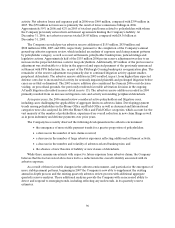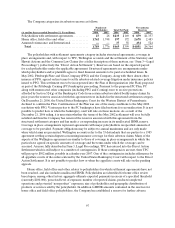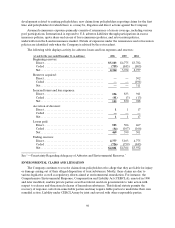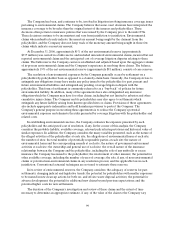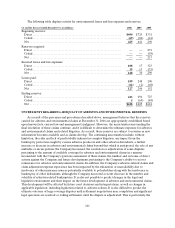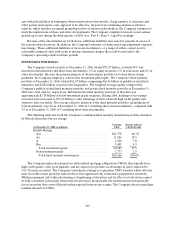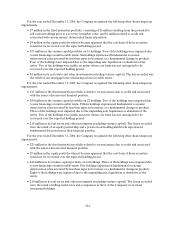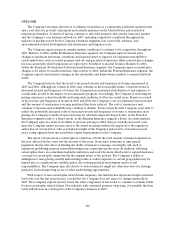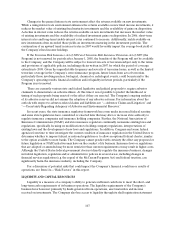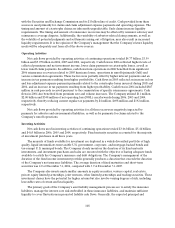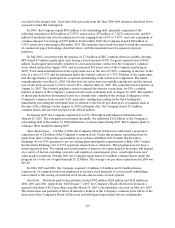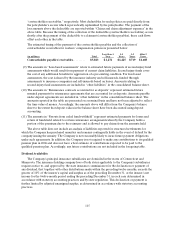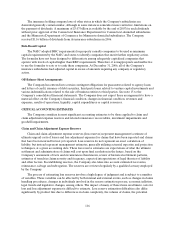Travelers 2006 Annual Report Download - page 118
Download and view the complete annual report
Please find page 118 of the 2006 Travelers annual report below. You can navigate through the pages in the report by either clicking on the pages listed below, or by using the keyword search tool below to find specific information within the annual report.106
OUTLOOK
The Company’s strategic objective is to enhance its position as a consistently profitable market leader
and a cost-effective provider of property and casualty insurance in the United States and in selected
international markets. A variety of factors continue to affect the property and casualty insurance market
and the Company’s core business outlook for 2007, including competitive conditions throughout the
majority of markets served by the Company’s business segments, loss cost trends, asbestos- and
environmental-related developments and reinsurance and litigation costs.
The Company expects property casualty market conditions to continue to be competitive throughout
2007. Relative to 2006, within the Business Insurance segment, the Company expects renewal price
changes to moderate and terms, conditions and insured values to improve for exposures susceptible to
catastrophe losses, such as coastal property and oil- and gas-related exposures, while renewal price changes
for non-catastrophe related exposures are expected to be subject to modest declines. Relative to 2006,
within the Financial, Professional & International Insurance segment, the Company expects renewal price
changes to be subject to modest declines. Also relative to 2006, within the Personal Insurance segment, the
Company expects renewal price changes in the automobile and homeowners markets to remain relatively
stable.
The Company believes that the trend of increased severity and frequency of storms experienced in
2005 and 2004, although not evident in 2006, may continue in the foreseeable future. Given the trend of
increased severity and frequency of storms, the Company has reassessed its definition of and exposure to
coastal risks, as well as the impact on its reinsuranceprogram. Accordingly, the Company is reviewing the
pricing, exposures, return thresholds and terms and conditions it offers in coastal areas. In part as a result
of the severity and frequency of storms in 2005 and 2004, the Company’s cost of reinsurance has increased
and the amount of reinsurance coverage purchased has been reduced. The cost of reinsurance may
continue to increase and availability may continue to decline. To the extent that the Company is not able to
reflect the potentially increased costs of increased severity and frequency of storms or reinsurance in its
pricing, the Company’s results of operations may be adversely impacted. In particular, in the Personal
Insurance segment (and, to a lesser extent, in the Business Insurance segment’s Select Accounts market),
the Company expects a delay in its ability to increase pricing to offset these potentially increased costs
since the Company cannot increase rates to the extent necessary without the approval of the regulatory
authorities of certain states. Also, particularly in light of the frequency and severity of storms in recent
years, rating agencies have increased their capital requirements for the Company.
The extent of losses from a catastrophe is a function of both the total amount of insured exposure in
the area affected by the event and the severity of the event. States have from time to time passed
legislation that has the effect of limiting the ability of insurers to manage catastrophe risk, such as
legislation prohibiting insurers from withdrawingfrom catastrophe-prone areas. In addition, following
catastrophes, there are sometimes legislative initiatives and court decisions which seek to expand insurance
coverage for catastrophe claims beyond the original intent of thepolicies. The Company’s ability or
willingness to raise pricing, modify underwriting terms or reduce exposure to certain geographies may be
limited due to considerations of public policy, the evolving political environment and/or social
responsibilities. The Company may also choose to write business it might not otherwise write for strategic
purposes, such as improving access to other underwriting opportunities.
With respect to non-catastrophe related claim frequency, the industry has experienced unprecedented
low levels over the last several years, a trend that the Company does not expect to change materially in
2007. The Company expects severity trend, the other component of loss trend, to continue to remain stable
for non-catastrophe related claims. Nevertheless, with continued pressure on pricing, it is possible that loss
ratios will increase in certain parts of the Company’s business in 2007.


